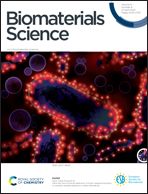In situ self-assembly of conjugated polyelectrolytes for cancer targeted imaging and photodynamic therapy†
Abstract
The construction of intelligent self-assembly systems with cancer targeting photodynamic therapy abilities is highly required for increasing the precise therapeutic efficiency in clinical treatment. Herein, a cationic water soluble conjugated polymer (PFT-SH) functionalized with thiol groups was designed and synthesized via a palladium-catalyzed Suzuki coupling reaction. Firstly, PFT-SH can enter cells and form loose aggregations by hydrophobic and π–π stacking interactions. Secondly, a high level of H2O2 in cancer cells oxidizes sulfhydryl groups to disulfide bonds and then forms more and larger aggregations. Finally, PFT-SH showed remarkable ROS producing ability under white light irradiation with 78% quantum yields (ΦΔ). Due to this unique self-aggregation property, PFT-SH was successfully used to achieve in situ self-assembly specifically inside cancer cells for targeted imaging. Both the specific aggregation of PFT-SH in cancer cells and its ROS producing ability led to its use in the targeted killing of cancer cells through efficient photodynamic therapy.

- This article is part of the themed collection: Biomaterials for Imaging and Sensing


 Please wait while we load your content...
Please wait while we load your content...